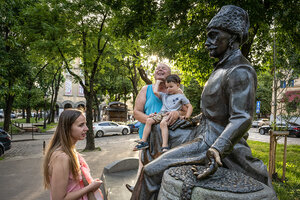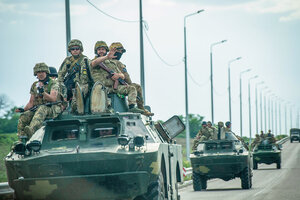Tale of two cities: Ukrainians’ war experiences differ starkly

A boy climbs a park statue, as Ukrainians seek to reestablish a degree of normal life, four months after Russian military forces first invaded Ukraine, and despite a recent wave of missile strikes across the country, in the western city of Lviv, Ukraine, on June 19, 2022.
Scott Peterson/Getty Images/The Christian Science Monitor
Lviv and Bakhmut, Ukraine
How Ukrainians experience the war with Russia depends very much on their location. In the east, people in the Donbas face daily bombardment and a Russian advance. The country’s west, despite daily air raid sirens and a recent wave of missile strikes, seeks a normal life. On Sunday, June 26, two Monitor reporters spent the day in Lviv, in Ukraine’s far west, and Bakhmut, in the far east, and recorded their observations. These are scenes from a war now split in two.
7:45 a.m., Bakhmut: On the road to the city, two green vans are marked with the number “300” – the code that they’re carrying wounded people. Military vehicles grind along the tarmac, transporting troops and rocket launchers to the northern front lines, where Ukrainian forces have been losing ground.
8:45 a.m., Bakhmut: At the gold-domed Russian Orthodox Church of the Annunciation, believers stand amid ornate icons, and breathe the incense-infused air. A priest, holding a thick Bible and an enamel crucifix, says his congregation is “praying for peace.” He blocks journalists from entering. Like others in the city, the priest thinks they’re a bad omen.
Why We Wrote This
Ukraine may be at war, but how Ukrainians endure depends greatly on where they live. For those in the west, life can seem almost normal. In the east, the conflict is an intrusive reality.
The sound of artillery and rocket exchanges erupt every few seconds outside town, creating a menacing backdrop. Bakhmut’s citizens expect to be Russia’s next priority in the Donbas. The city is already a target.
9:15 a.m., Lviv: It takes 15 minutes for Svit Kavy (“Coffee World”) to attract its first customer. Lvivians rise late on weekends, and even later during Ukraine’s wartime curfew. Under the cafe’s small awning, facing a rose garden, people enjoy coffee and croissants.
9:30 a.m., Bakhmut: Amid a cluster of metal kiosks, shop owner Serhii spills a sack of dried bread for a dozen noisy pigeons. With three gold-capped teeth and a scar on the bridge of his nose, he says he doesn’t know if shelling affects these “birds of peace.” But his dog Elza hides at the noise.
Elza belonged to Serhii’s son until he evacuated to Europe in late March from Mariupol, a southern city obliterated by weeks of Russian shelling. More than half of Bakhmut’s shops have closed, he says, and business is getting “worse and worse.”
“I am not falling down from my optimism,” he says.
9:30 a.m., Lviv: Golden statues of angels and saints climb the inside pillars of Lviv’s Bernardine church, up to a ceiling fresco of the ascension. “Pray for peace, pray for freedom, pray for Jesus, pray for the army,” the priest chants. “Jesus, have mercy on us,” the congregation sings back.
The call and response continues for several minutes and congregants kneel on pastel-colored pads to soften the stone floor. “God wishes that all of us would have peace,” says the priest.
10:20 a.m., Bakhmut: At a military hospital, tension is high and blood-stained stretchers testify to a nationwide daily death toll of 100 to 200 Ukrainian soldiers.
Grygorii, a rotund uniformed security guard with a gray beard, is nicknamed Hottabych for his resemblance to a Soviet-era children’s film character. “We’re not having too much fun here,” he says.
Then he barks orders to soldiers to park their cars under trees “so they cannot be seen from the sky.”
10:45 a.m., Bakhmut: Across the street, a group of soldiers waits for news of a concussed comrade. Volodymyr Doroshenko, who volunteered for service the day Russia invaded, is among them. His unit first deployed to Irpin, a Kyiv commuter town.
Though Irpin was largely destroyed by Russian artillery, “the intensity of the shelling was nothing like it is here,” he says, the back of his civilian car packed with rocket-propelled grenade rounds and body armor.
Ukrainian troops billet in abandoned buildings on the empty north side of town, pocked with shell craters. “Be very careful,” says a soldier nicknamed Boroda, who stepped out of a van to check press credentials. “It’s not safe.”
11:00 a.m., Lviv: The second air raid siren of the day whines as Zinovii stands outside church with his son. Around his black satchel, the father carries a wreath of yellow and blue flowers, believed to bring safety. “When you personally wait for this help from God, he will definitely come and bring peace,” he says. He thinks the people in the Donbas should do the same.
11:20 a.m., Bakhmut: A security guard named Sasha stands at a trolley-bus repair station, down the street from a cratered Soviet factory. “We still have to live somehow, though there is shooting everywhere,” Sasha says. Inside, a mechanic tightens lug nuts on bus wheels. There hasn’t been an air raid siren all day.
11:30 a.m., Lviv: Near a tram stop, a soldier stands guard with a rifle on his back and an AirPod in his ear.
1:25 p.m., Bakhmut: An alarmingly close outgoing artillery round roars into the sky, and everyone at a bus stop jerks back with fear.
“It’s unpleasant, of course,” says Olha Mytnyk, a sumo wrestling instructor waiting for the bus. On her phone, Ms. Mytnyk shows videos of classes she taught to children, to a soundtrack of Lady Gaga’s “Poker Face.”
“I’ve coped with it. I have learned to live with it,” she says. “But I can’t get used to it.” From her designer bag, a woman in a tight blue dress and mirror sunglasses pulls a sopilka – Ukraine’s traditional woodwind instrument resembling a recorder – and starts playing.
1:30 p.m., Lviv: On his day off this week, Andrii Sydorov waits for his wife’s shift to end at an art gallery. Sitting on a bench under a small tree, he says the two of them fled their home in Zaporizhzhia, in southeast Ukraine, in March when the Russians shelled the city’s nuclear plant.
Their daughter studies in Lviv, and both of them easily found work. “Our lives are almost normal,” says Mr. Sydorov. “We would really love to go back to our home. But obviously we can’t.”
1:50 p.m., Bakhmut: More nearby bursts of outgoing fire and 4-year-old Anton leaps from a park playground and rushes to his mother, Elena.
“Let’s go home! Let’s go home!” he says, tugging at her arm.
At home, the boy tells her “my heart is broken” by the sounds of war. He knows who Russian President Vladimir Putin is, says Elena: “The one who orders Ukraine to be bombed.”
2:45 p.m., Lviv: At a skate park next to the fire station, a dozen or so teenagers ride scooters on metal ramps. Some twist their handlebars, others their footpad. Shirtless, one teenager calls to his friends that he just learned a new trick.
They wait and watch.
Riding up and down the tallest ramp for momentum, he launches into the air and spins the footpad with his hand. He doesn’t land a full 360; neither, laughing, do his friends who try the same move.
3:50 p.m., Bakhmut: For Oksana Shpachenko’s family, four months of war is enough. They board a yellow evacuation van run by the Ukrainian charity Help People. The van has room for 18 but only six are on board – a situation likely to change soon. The war is coming closer to Bakhmut, and Ukrainian military forces are pouring into the area.
In the end, says Ms. Shpachenko, the decision to leave was “quick.”
“Our bags were ready,” she says.
7:15 p.m., Lviv: There’s a street carnival on the long boulevard outside the opera house. At one of the stands, a vendor has set up paper targets of Mr. Putin. He sells several shots apiece with a plastic AK-47 BB gun.
Half a mile down at a dog park, Ivan Bolgarov stands next to his small brown-and-black hound, Marka. “I just wanted someone to distract me, someone to care about,” says Mr. Bolgarov, who adopted Marka in March. “When you find yourself having to bury more friends in one month than you did your whole life, you have to have something to balance that.”
9:30 p.m., Lviv: The outdoor tables on Virmenska Street, near the city center, are packed but they won’t be for long. On weekends before the war, people often stayed out until midnight. Now restaurants close by 10 p.m.
Yulia Malish has just finished dinner with two friends. Her day started with the news that a missile had hit an apartment in Kyiv, injuring six people and killing one. “I’ve already adapted to the new reality,” says Ms. Malish. “But on the other hand I was still very emotional.” Waiters pick up chairs behind her and clean tables under strings of colorful Christmas lights.
It’s almost Lviv’s closing time, and Ms. Malish and her friends have to get home before the 11 p.m. curfew.
She has spent the day surfing Instagram, walking her dog, relaxing at home, and going out to eat with friends. More or less, she says, it’s been a pretty typical day.
“War,” says her friend Sonya Vyshnevska before they turn for home, “has become like another type of routine.”
Reporting for this story was supported by Oleksandr Naselenko in Bakhmut and Iryna Kovalchuk in Lviv.

